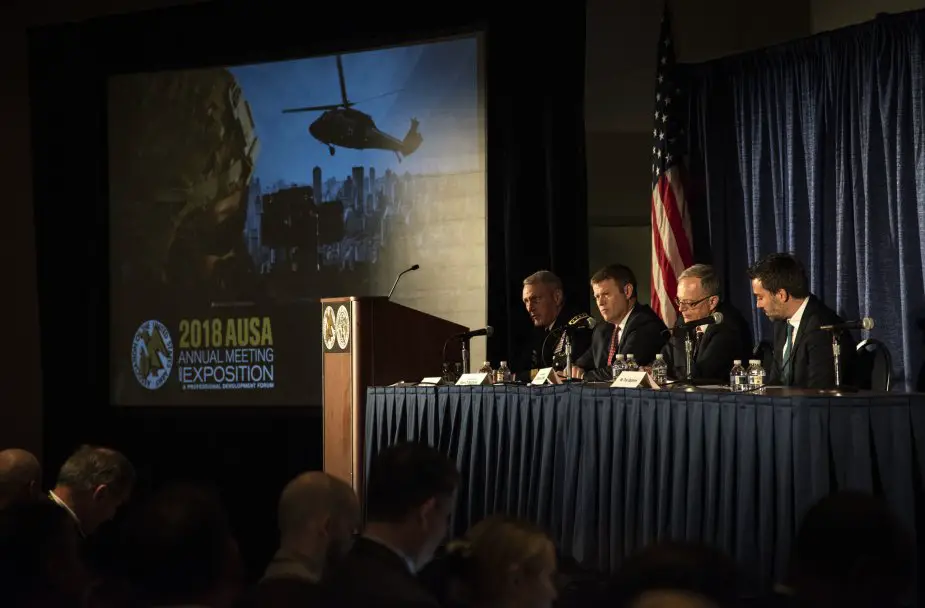US Army Futures Command looks ahead to more
In just a year, the Army Futures Command has officially stood up, opened a headquarters in the Texas capital, and created a group of cross-functional teams currently working to streamline an outdated acquisition process. Sean Kimmons, Army News Service, explains.

Panelists discuss modernization during a Futures Command Contemporary Military Forum at the Association of the United States Army Annual Meeting and Exhibition, Oct. 08, 2018, in Washington, D.C. From left: Gen. Mike Murray, commanding general of U.S. Army Futures Command; Under Secretary of the Army Ryan McCarthy; Assistant Secretary of the Army for Acquisition, Logistics and Technology Bruce Jette; and Trae Stephens with Startups in Government Space. (Photo credit: U.S. Army/John G. Martinez)
While still growing, the command has already seen positive results toward its goal to make Soldiers and units more lethal. In many cases, the command has been able to cut traditional requirements in the acquisition timeline by half or more, which could put new capabilities in the hands of Soldiers years faster than before. "Army Futures Command has been an opportunity for us to bring two key stakeholders together -- acquisitions and requirements," said Under Secretary of the Army Ryan D. McCarthy during a panel Monday at the 2018 AUSA annual meeting. "We can no longer continue the mindset of handing off a baton between one stakeholder to another. We've got to become like a football team, shoulder-to-shoulder marching down the field together."
A recent example of that collaboration is with a new battlefield heads-up display, called the Integrated Visual Augmentation System. After the Soldier Lethality Cross-Functional Team, or CFT, identified technology that makes it possible to deliver a single system across the force, there are plans to field that system by the end of fiscal year 2020. "Given sufficient resources, Army Futures Command and the CFTs will continue to produce similar results," said Gen. John M. Murray, the Futures Command commander. Those sorts of results are expected to be replicated as the command reaches out to innovators, entrepreneurs and other industry partners on emerging technology.
Near its headquarters in Austin, Texas, the command has set up an Army Applications Lab inside an incubator hub. It also held a "hack-a-thon" competition last month and handed out three $15,000 awards to further refine counter-drone concepts.
There is also the Army Expeditionary Technology Search, or xTechSearch, a new program that plans to award $125,000 apiece to 12 small business finalists. One of those finalists could earn an additional $250,000 to help develop their technology. "Whether you work with industry, [science and technology], academia, or just have a bright idea, we're interested," Murray said. Desired technology will tackle one of the Army's six modernization priorities -- long-range precision fires, next generation combat vehicle, future vertical lift, network, air and missile defense, and Soldier lethality.
The fiscal year 2019 National Defense Authorization Act, which was signed by the president in August, earmarked $10.2 billion to help fund those efforts. The command itself has an annual budget of about $100 million. "We're moving out and there's no turning back," McCarthy said. "We've shown the will to act over the last year, and now we have to show the will to follow through." As the command moves toward full operational capability next summer, it will also attempt to recruit and hire the best as part of its talent management strategy. With about 50 permanent hires now, the command could eventually have around 500 military and civilian personnel at its headquarters. The total force of the command will be roughly 14,000 personnel, after several existing organizations move under it.
Along with a shift to new modernization efforts, Murray recognized that the changes revolving around his command -- the most significant Army reorganization effort since 1973 -- will be difficult. "I fully understand that change is hard," he said. "It will be disruptive and uncomfortable. Building a team from existing organizations dispersed across the United States will take leadership and patience. But without pain, there will be no gain."


























